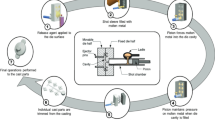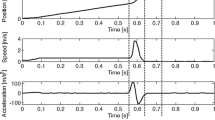Abstract
High-pressure die casting (HPDC) is particularly suitable for high production rates and it is applied in several industrial fields; actually, approximately half of the world production of light metal castings is obtained by this technology. An overview of the actual status of HPDC technology is described in the current work, where both critical aspects and potential advantages are evidenced. Specific attention is paid to the quality requirements from the end users, as well as to the achievable production rate, the process monitoring and control, and the European and worldwide scenario. This overview leads to individuate the most relevant challenges for HPDC industry: “zero-defect” production, real-time process control, understanding the role of the process variables, process optimization, introduction of research and development activities, and disseminating the knowledge about HPDC technology. Performing these actions, HPDC foundries could achieve a more mature and efficient approach to large end users and exploit their really relevant potential.






Similar content being viewed by others
References
E.J. Vinarcik, High Integrity Die Casting Processes, 1st ed. (New York: Wiley, 2003), pp. 3–25, 145–156.
L.J.D. Sully, Casting, ed. ASM Metals Handbook (Materials Park, OH: ASM International, 1990), pp. 611–632.
D.R. Gunasegaram, B.R. Finnin, and F.B. Polivka, Mater. Forum 29, 190 (2005).
D.R. Gunasegaram, B.R. Finnin, and F.B. Polivka, Mater. Sci. Technol. 23, 847 (2007).
M.R. Ghomashchi, J. Mater. Process. Technol. 52, 193 (1995).
M.S. Dargusch, G. Dour, N. Schauer, C.M. Dinnis, and G. Savage, J. Mater. Process. Technol. 180, 37 (2006).
S. Otarawanna, H.I. Laukli, C.M. Gourlay, and A.K. Dahle, Metall. Mater. Trans. A 41, 1836 (2010).
F. Bonollo and G. Timelli, Aluminium Alloy Castings: The EU StaCast Guide to Defects Classification, Mechanical Potential and Design Issues, 1st ed. (Milano: Assomet Servizi, Associazione Italiana di Metallurgia, 2014).
W.G. Walkington, Die Casting Defects—Causes and Solutions, 1st ed. (Des Plaines, IL: North American Die Casting Association, 2003), pp. 1–11.
E. Gariboldi, F. Bonollo, and P. Parona, Handbook of Defects in HPDC, 1st ed. (Milano: Associazione Italiana di Metallurgia, 2010).
F. Bonollo, International Diecasting Directory 2004 (Brescia: Edimet, 2004).
European Foundry Association, Annual Report 2012 (Brussels: CAEF, 2013), p. 96.
C. Reilly, N.R. Green, and M.R. Jolly, Appl. Math. Model. 37, 611 (2013).
F. Bonollo, J. Urban, B. Bonatto, and M. Botter, Metall. Ital. 97, 23 (2005).
G. Timelli and F. Bonollo, Metall. Sci. Technol. 26, 2 (2008).
L.H. Kallien, T. Weidler, and U. Gauermann, Giesserei 99, 52 (2012).
L. Wang, M. Gershenzon, V. Nguyen, and G. Savage (Paper Presented at the Proceedings of the Cast Expo’05, St. Louis, MO, 16–19 April 2005).
L. Wang, M. Gershenzon, V. Nguyen and G. Savage (Paper Presented at the Proceedings of the 111th Metalcasting Congress, Houston, TX, 15–18 May 2007).
L. Wang, M. Makhlouf, and D. Apelian, Int. Mater. Rev. 40, 221 (1995).
N. Gramegna, E. Della Corte, G. Quaglia, F. Garcia Lorente, I. Loizaga, and S. Berrocal, Metall. Ital. 103, 19 (2011).
European Foundry Association, Aluminium in Cars: Unlocking the Lightweighting Potential (Brussels: EAA, 2013), pp. 1–15.
Acknowledgements
This work was developed within the European Project MUSIC (Multi-layers Control and Cognitive System to drive metal and plastic production line for Injected Components, FP7-FoF-ICT-2011.7.1, Contract No. 314145). This article is the result of a survey carried out by the authors with key persons in HPDC fields, who are gratefully acknowledged: Jeorg and Uwe Gauermann (Electronics GmbH), Lothar Kallien (GTA, Aalen University), Marc Schnenider (MAGMA GmbH), Lars Arnberg (NTNU, Trongheim University), Aitor Alzaga (Tekniker), and Luca Baraldi and Flavio Cecchetto (MOTUL-Baraldi).
Author information
Authors and Affiliations
Corresponding author
Rights and permissions
About this article
Cite this article
Bonollo, F., Gramegna, N. & Timelli, G. High-Pressure Die-Casting: Contradictions and Challenges. JOM 67, 901–908 (2015). https://doi.org/10.1007/s11837-015-1333-8
Received:
Accepted:
Published:
Issue Date:
DOI: https://doi.org/10.1007/s11837-015-1333-8




